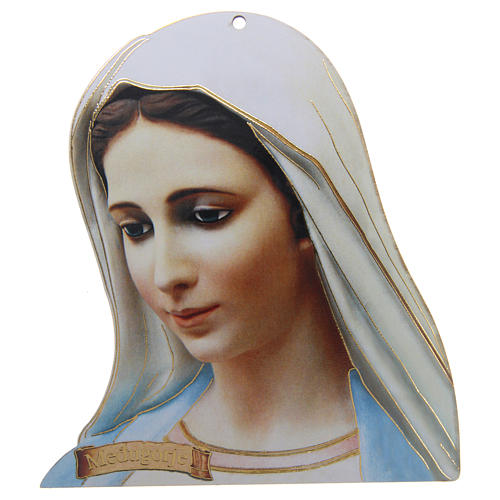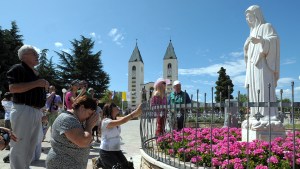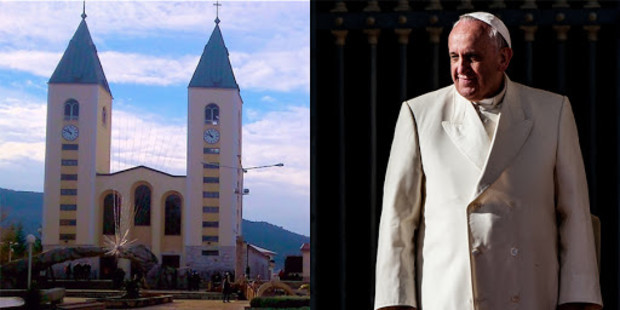Though the Mother of God “loves everyone” and “isn’t the boss of a Post Office, there to send messages every day,” says Francis regarding Medjugorje, “God performs miracles in Medjugorje. In the midst of the craziness of human beings, God continues to work miracles.”

Read more:
Images of Our Lady of Medjugorje
These are some of his reflections now published in Italian, from a conversation with Fr. Alexandre Awi Mello, secretary of the Dicastery for Laity, the Family, and Life. Their dialogue was published in a book titled “She’s My Mother. Encounters with Mary,” just released this year in Italian (originally published in Portuguese in 2013).
“A person’s obedience to the Church,” the pontiff pointed out, is a criteria for discernment when there are supposed apparitions and when there are “messages” and “interior locutions” that proceed from possible “specially gifted people.”

Read more:
Pope’s envoy details plans to expand Medjugorje shrine
The day that Bergoglio prohibited a meeting about apparitions in Medjugorje
Regarding the case of Medjugorje, which is still being studied, Pope Francis recounts that “when I was in Buenos Aires, I prohibited a meeting, which took place anyway. They knew, however, that I wasn’t in agreement.”
Francis is referring to what happened when one of the Medjugorje “visionaries” visited the archdiocese he was heading at the time, for an encounter scheduled at a church. Then-Archbishop Bergoglio opposed the meeting (without expressing his opinion regarding the authenticity of the apparitions) because “one of the visionaries had spoken and explained a bit of everything, and Our Lady was supposed to appear to him at 4:30 PM. That is to say, he knew the Virgin Mary’s schedule. So I said: No, I don’t want this kind of thing here. I said no, not in the church.”
The pope noted that “we must distinguish; however, despite this, God performs miracles in Medjugorje. In the midst of the craziness of human beings, God continues to work miracles.”
In the same vein, he says that perhaps there are “more personal phenomena.”
“I receive letters, but we understand that [the things they relate] are more psychological than anything else. We have to distinguish things clearly. I think there’s grace in Medjugorje. There’s no denying it. There are people who have conversions. But there’s also a lack of discernment, and I don’t want to say there’s sin, because the people don’t know where sin begins, but, at least there’s a lack of discernment.”
Why does Francis love Mary so much?
Speaking today, with the backdrop of the Synod on Young People, the author of the book commented on how his book came about, and on the pope’s ecclesial vision of a Church that is a mother, like Mary: welcoming and loving toward new generations.
“I had the opportunity a while back to interview Pope Francis about his relationship with the Virgin Mary, and it seems to me that it’s not only a pious or devotional relationship; it’s something that impacts his vision of the Church.Why does the pope love Mary so much? Because in her, he has seen an image of the Church, of what it should be: a mother, welcoming, a teacher, a friend, merciful.”
“So, I think it’s important to consider this maternal dimension of the Church which loves and welcomes the young people, who need it so much,” said Fr. Mello, during the press conference on the Synod’s work, held at the Press Office of the Holy See.
Mello is the former director of national youth ministry in Brazil.
Regarding Medjugorje, just months after the pope began his pontificate, as he presided the Mass in the chapel of Casa Santa Marta on November 14, 2013, he explained that the spirit of worldly curiosity, which seeks knowledge for its own sake and looks for things that are more and more strange and unusual, leads people away from true wisdom and from God’s beauty.
In this context, he expressed his doubts about the visionaries, who say they have messages from the Virgin Mary at fixed intervals.
The visionaries assert that they’ve been seeing the Virgin Mary since 1981.
There is talk that perhaps the Church could eventually recognize only the first seven apparitions, in light of a report prepared by a group of Church officials about Medjugorje.
The Marian apparitions to the six visionaries, who are now adults, are said to continue even today.
Difficulties expressed by the Congregation for the Doctrine of the Faith—which resulted from the Congregation’s study of the matter in 2016—increase the complexity of the problem.
For now, it is being discerned whether or not the church built in Medjugorje (Bosnia-Herzegovina) in honor of the Virgin Mary could become a pontifical shrine, a possible solution for ending the conflicts between the Franciscans, who are in charge of the shrine, and the bishop of Mostar, the diocese in which the site is located.
Dialogue with journalists
During his dialogue with journalists on the way back from the shrine at Fatima, which just celebrated the 100th anniversary of the apparition of the Virgin Mary, the pope revealed the results of the commission that identified a very clear difference between the beginning of the phenomenon which is “considered supernatural” (June 24 – July 3, 1981) and what happened after the first visions.
The commission’s report explains that the six visionary children were psychologically normal, that they were surprised by the apparition, and that there was no external influence on what they said they saw.
As was the case with the three little shepherds of Fatima, the seers of Medjugorje refused to tell what they had seen, despite having been arrested by the police and threatened with death. Also, the hypothesis that the phenomenon could be demonic was rejected.
In the end, Francis gave a positive opinion of the work of the commission—presided by Cardinal Camillo Ruini and instituted by Pope Benedict XVI in 2010—whose work ended in 2014.
For pastoral reasons, the commission took a stance in favor of removing the ban on pilgrimages to Medjugorje. Thus, the Ruini report concludes that the shrine should be under the authority of the Holy See, and suggests that the parish be converted into a pontifical shrine.
Last year, the pontiff sent Polish Archbishop Henry Hoser to the Marian shrine to evaluate the situation and in particular to study the pastoral care being provided for the local faithful and for pilgrims. The purpose of the visit was to obtain more information so as to plan future initiatives for pastoral care.

Read more:
Archbishop Henryk Hoser to Aleteia: We should not be worried about Medjugorje!

